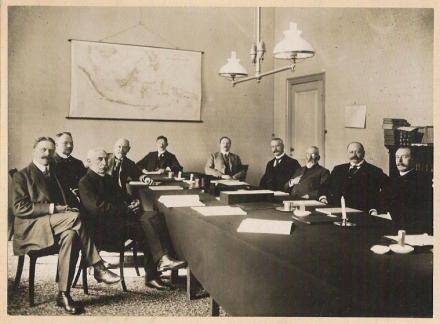History of the Electoral Council
The history of the Electoral Council dates back to 1917, the year in which a new electoral system - of proportional representation - was introduced in the Netherlands. In December that same year, the central electoral committee was formed, the forerunner of the Electoral Council.

The central electoral committee became charged with gathering the results of the elections to the House of Representatives and determining the allocation of seats. In the district system, which was used in the Netherlands before 1917, there was no need for a central electoral body. For the results were determined by the principal electoral committee of each electoral district.
Election results
Initially, the central electoral committee only dealt with the elections to the House of Representatives. This changed in 1922, when the members of the Senate, too, were elected according to the system of proportional representation. Since then, the central electoral committee has determined the results of these elections as well.
After the European Elections Act entered into force in 1978, the Electoral Council has also acted as central electoral committee for the elections to the European Parliament.
Under the Interim Referendum Act, which was in effect from 2002 to 2005, the Electoral Council was the central electoral committee for national advisory corrective referenda. But these were never held. However, the Electoral Council did act as central electoral committee for the consultative referendum on the European Constitution in 2005.
Under the Advisory Referendum Act, which was in effect from 2015 to July 2018, the Electoral Council was central electoral committee for national advisory referenda.
Advisory body
When the central electoral committee was formed, it was determined that it was to advise, upon request, on the implementation of the Elections Act to the Minister of the Interior and Kingdom Relations. In practice, the advice of the central electoral committee was not limited to implementation issues, but advice was also given on more radical amendments to the Elections Act.
Change of name
In 1947, it was requested to draft a new Elections Act, which was the reason for the proposal to change the name "central electoral committee" into "Electoral Council". The change of name was laid down in the 1951 Elections Act.
Unbundling
From the time of formation, the central electoral committee was housed in the Ministry of the Interior. In time, the Electoral Council was increasingly supported by civil servants of the Ministry of the Interior who, under the directions of the Electoral Council, were involved in electoral legislation. Over the past few years, the process has reversed: unbundling of the Electoral Council and the Ministry of the Interior and Kingdom Relations.
A first - substantive - step was taken with the new Elections Act of 1989, when the preparation of legislation was removed from the Electoral Council. A second - organisational - step followed at the beginning of 2006, when the secretariat of the Electoral Council was removed from the Constitutional Affairs and Legislation Department. It has been functioning as an independent unit since. The civil servants of the secretariat are employed by the Ministry of the Interior and Kingdom Relations, but, pursuant to Article x of the Advisory Bodies Framework Act, they are only accountable to the Electoral Council.